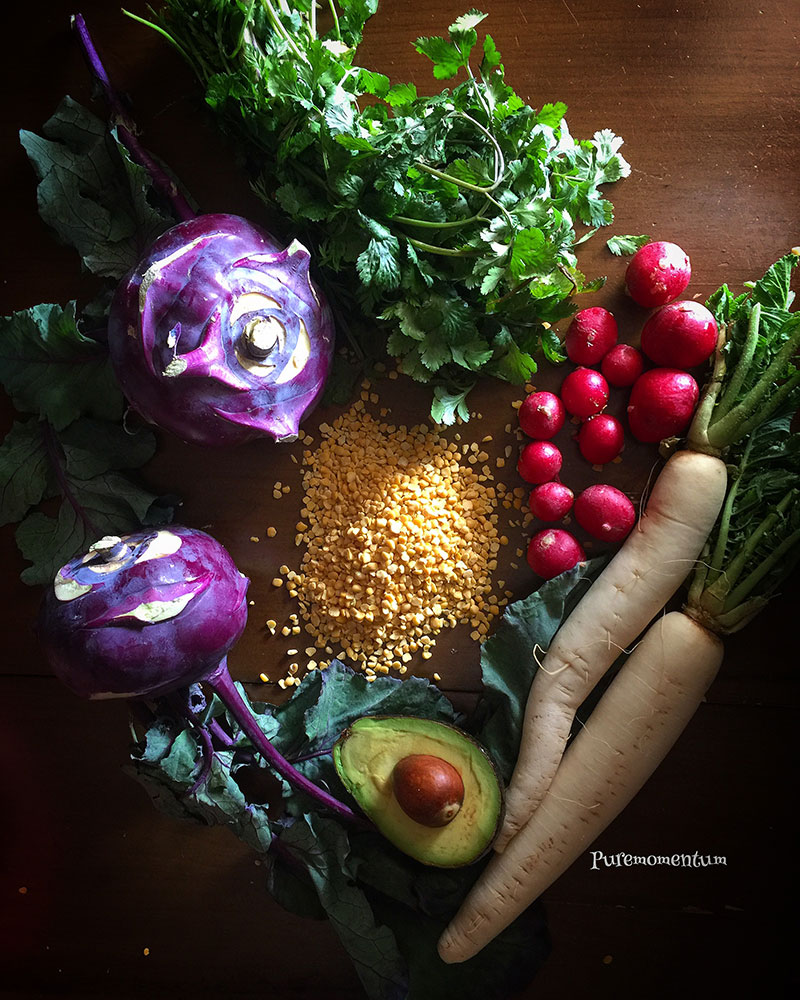
When I first started browsing all over Instagram one of the first vegan tags I found was #Eattherainbow, foods that have life, color and texture. Why are all these people obsessed with colour?
Pigments are the means by which the energy of sunlight is captured for photosynthesis. Due to the absolute necessity of light, plants have developed numerous light range capturing capability. Common pigments include β-carotene, lycopene, lutein and zeaxanthin. What are they good for humans though?
Major plant pigments and their occurrence.
-
- Chlorophylls: in Green plants. Promote deactivation of carcinogens, wound healing, liver detox.
-
- Carotenoids: as Carotenes and xanthophylls (e.g. astaxanthin) in Bacteria, Green plants (masked by chlorophyll), vegetables like carrots, mangoes and so on. Found in Oranges, reds, yellows, pink colours. Prevent carcinogenesis, cardiovascular disease and eyesight.
-
- Flavonoids: Anthocyanins, aurones, chalcones, flavonols and proanthocyanidins. Produce many colors in flowers. Common in plants such as berries, eggplant, and citrus fruits. Present in certain teas, wine, and chocolate. Found in Yellow, red, blue, purple colour plants. Delay cognitive disorders and cancer.
- Betalains: Betacyanins and betaxanthins. In Flowers and fungi. Red to violet, also yellow to orange colour plants. Powerful antioxidants, protect us from heart disease, liver damage, and cancer.
So, fruits and veggies are grouped according their colour palette. Now how brilliant is that? Green, orange/yellow, red, purple, white. Five colour groups characterised by specific phytonutrients & pigments that contain similar vitamins & benefits.
Basically, the richer the color – the better. Eat the skins, eat the seeds, eat a good variety. Mix it up and take your taste buds places they have never gone!
Then, I investigated further only to be amazed by the findings. My search engines are the same I use for my medical research. PubMed, Medscape, uptodate, all are some of the most trustworthy search engines in science. First striking discovery was that the high intake of white fruits and vegetables may protect against stroke. Nutrients in White fruits and Vegetables Include: Beta-glucans & lignans that provide powerful immune boosting activity. These nutrients also activate natural killer B and T cells, reduce the risk of colon, breast, and prostate cancer, and balance hormone levels, reducing the risk of hormone-related cancers.(1) Orange/yellow & red/purple vegetables and fruit are also inversely associated with the risk of colorectal cancer.(2)(3) All of the above mentioned cancers are not only common, they are deadly and disabling, sometimes chronic diseases of which people suffer greatly. It all comes down to this:

Increased intake of fruits and vegetables is linked to
a lower risk of premature death.
Bottom line:
Eat the rainbow.
MANY DIFFERENT COLOURS.
Regularly. Not twice a week!
EVERY SINGLE DAY.
It requires commitment, but there’s a tremendous payback and you are worth it.
Bibliography
- High consumption of vegetable and fruit colour groups is inversely associated with the risk of colorectal cancer: a case-control study. Luo WP, Fang YJ, Lu MS, Zhong X, Chen YM, Zhang CX. Br J Nutr. 2015 Apr 14;113(7):1129-38. doi: 10.1017/S0007114515000331. Epub 2015 Mar 16.
-
Colors of fruit and vegetables and 10-year incidence of stroke. Oude Griep LM, Verschuren WM, Kromhout D, Ocké MC, Geleijnse JM. Stroke. 2011 Nov;42(11):3190-5. doi: 10.1161/STROKEAHA.110.611152. Epub 2011 Sep 15.





